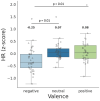Interoceptive signals and emotional states shape temporal perception through heart rate modulation
- PMID: 40678439
- PMCID: PMC12267279
- DOI: 10.3389/fpsyg.2025.1610347
Interoceptive signals and emotional states shape temporal perception through heart rate modulation
Abstract
Background: This study investigated the relationships between interoceptive signals, emotions, and time perception, with a particular focus on the mediating role of heart rate (HR). Emotional video stimuli were used to elicit specific emotional responses, while participants' attentional focus was manipulated (internal vs. external) to examine its influence on temporal judgments.
Methods: We tested several hypotheses using a combination of linear mixed models and Bayesian mediation analysis. Emotional content, heart rate, attentional focus, and interoceptive accuracy were analyzed for their effects on time perception. Participants viewed 36 video clips designed to elicit positive, negative, or neutral emotions, and their duration estimation errors, normalized heart rates, and subjective ratings were recorded.
Results: Emotional content significantly influenced time perception. Negative and neutral videos were underestimated in duration, while positive videos showed smaller estimation errors. Heart rate partially mediated the effect of emotions on time perception, with slower heart rates linked to greater underestimation of durations. However, this mediating effect was smaller compared to other potential mechanisms not explored in this study. Contrary to prior research, no correlation was found between interoceptive accuracy and time perception precision, likely due to methodological differences in task design and measures of interoception. An internal focus of attention was associated with greater underestimation of time and lower normalized heart rate. However, no significant interaction was observed between attentional focus, heart rate, and emotional valence.
Conclusion: These findings highlight the multifaceted nature of time perception, emphasizing the role of both physiological processes and subconscious interoceptive signals. The partial mediation of heart rate underscores its importance in shaping temporal judgments, while the lack of interaction with attentional focus suggests that these effects may be driven by unconscious mechanisms. The results contribute to a deeper understanding of how emotions and bodily signals interact to shape time perception and underscore the need for further research into individual differences and unconscious influences on temporal judgments.
Keywords: awareness; emotions; heart rate; interoception; time perception.
Copyright © 2025 Volodina, Rusinova, Terenteva and Kosonogov.
Conflict of interest statement
The authors declare that the research was conducted in the absence of any commercial or financial relationships that could be construed as a potential conflict of interest.
Figures





Similar articles
-
The relevance of cardiac and gastric interoception for disordered eating behavior.J Eat Disord. 2025 Jun 16;13(1):114. doi: 10.1186/s40337-025-01284-0. J Eat Disord. 2025. PMID: 40524251 Free PMC article.
-
The Effect of Labeling During Simulated Contact on Attitudes Toward Autistic Adults.Autism Adulthood. 2025 Feb 5;7(1):93-99. doi: 10.1089/aut.2023.0081. eCollection 2025 Feb. Autism Adulthood. 2025. PMID: 40151654
-
Eliciting adverse effects data from participants in clinical trials.Cochrane Database Syst Rev. 2018 Jan 16;1(1):MR000039. doi: 10.1002/14651858.MR000039.pub2. Cochrane Database Syst Rev. 2018. PMID: 29372930 Free PMC article.
-
[Volume and health outcomes: evidence from systematic reviews and from evaluation of Italian hospital data].Epidemiol Prev. 2013 Mar-Jun;37(2-3 Suppl 2):1-100. Epidemiol Prev. 2013. PMID: 23851286 Italian.
-
Home treatment for mental health problems: a systematic review.Health Technol Assess. 2001;5(15):1-139. doi: 10.3310/hta5150. Health Technol Assess. 2001. PMID: 11532236
References
-
- Bar-Haim Y., Kerem A., Lamy D., Zakay D. (2010). When time slows down: the influence of threat on time perception in anxiety. Cogn. Emot. 24, 255–263. doi: 10.1080/02699930903387603 - DOI
LinkOut - more resources
Full Text Sources

